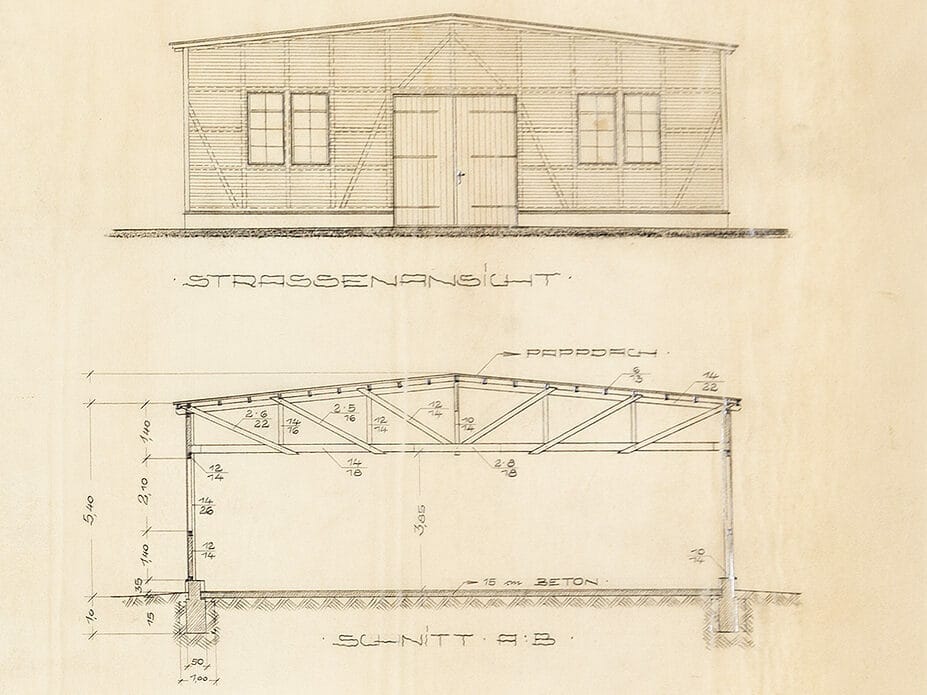Insignificance 3: Mourning Work

All drawings contain traces of all previously drawn mediations. [1] All drawings are silent acts of memorialising (by employing inter-subjective readings of iconography, lineage, parody, reverie and reflexivity) what has been drawn before, or thought to have been so, or simply, what has been, consciously misplaced. [2]

From the catalogue notes: ‘Plans for the Berlin apparel and fittings factory ‘Zorn & Co’ in Märkisch Buchholz, a town in Brandenburg, Germany, including a completion plant, offices, service buildings (command-and-barrack style building). Fritz, the son of Bodo Ebhardt, took over his father’s office. Professor Robert Jan van Pelt: I had a look at the drawings, and they appear typical for the tens of thousands of barracks that were built in Germany between 1933 and 1945 in order to gear up the economy for first war and then total war. In the Auschwitz archives I encountered many of such drawings. There were a few standardised types. A popular one was that developed by the Reichsarbeitsdienst (RAD or Reich Labour Service).’
The text above is excerpted from Gordon Shrigley, Insignificance: A short discourse on the physical and ideational economy of line within architectural representation (Solitude Editions, 1998). Now, twenty years after Insignificance was first published, Gordon Shrigley has revisited the publication for a series of postings on Drawing Matter. Each of these posts pair passages from the book with drawings in the Drawing Matter collection to extend the discussions set out in the original publication.
Find all pairings to date, here.
Notes
- ‘Hence the idea of describing these dispersions themselves; of discovering whether, between these elements, which are certainly not organised as a progressively deductive structure, nor as an enormous book that is being gradually and continuously written, nor as the oeuvre of a collective subject, one cannot discern a regularity: an order in their successive appearance, correlations in their simultaneity, assignable positions in a common space, a reciprocal functioning, linked and hierarchized transformations… it would describe systems of dispersion.’
And further:
‘Whenever one can describe, between a number of statements, such a system of dispersion, whenever, between objects, types of statement, concepts, or thematic choices, one can define a regularity (an order, correlation, positions and functioning’s, transformations), we will say, for the sake of convenience, that we are dealing with a discursive formation.’
Michel Foucault, The Archaeology of Knowledge, trans. A.M. Sheridan Smith (Tavistock Publications, 1972), 37–38. - ‘All these wounds can be given names. Their names are strewn across the field of our unconscious like so many secret obstacles to the quiet perpetuation of the “modern project.” Under the pretence of guarding that project the men and women of my generation in Germany imposed on their children a forty-year silence about the ‘Nazi interlude.’ This interdiction against anamnesis stands as a symbol for the entire western world. Can there be progress without anamnesis? Anamnesis constitutes a painful process of working through, a work of mourning for the attachments and conflicting emotions, loves and terrors, associated with those names… We have only gotten as far as a vague, apparently inexplicable, end-of-the-century melancholy.’
Jean-Francois, Lyotard, Ticket to a New Decor, trans. Brian Massumi and W. Niesluchowski, Copyright 1 (Fall 1987), 14–15.

– Gordon Shrigley